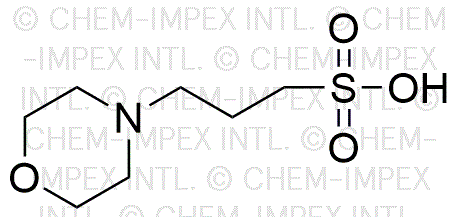3-N-Morpholinopropanesulfonic acid is widely utilized in research focused on:
- Biological Buffers: This compound is commonly used to create buffers in biological experiments, maintaining pH stability in cell culture and enzyme assays, which is crucial for accurate results.
- Pharmaceutical Formulations: It serves as an excipient in drug formulations, enhancing solubility and stability of active pharmaceutical ingredients, thereby improving the efficacy of medications.
- Protein Purification: In biochemistry, it is employed in the purification processes of proteins, helping to maintain the desired pH and ionic strength during chromatographic techniques.
- Cosmetic Products: The compound is also used in cosmetic formulations, acting as a pH stabilizer and enhancing the texture and feel of creams and lotions.
- Research Reagents: It is a valuable reagent in various chemical syntheses and analytical procedures, providing reliable performance compared to other similar compounds.
General Information
Properties
Safety and Regulations
Applications
3-N-Morpholinopropanesulfonic acid is widely utilized in research focused on:
- Biological Buffers: This compound is commonly used to create buffers in biological experiments, maintaining pH stability in cell culture and enzyme assays, which is crucial for accurate results.
- Pharmaceutical Formulations: It serves as an excipient in drug formulations, enhancing solubility and stability of active pharmaceutical ingredients, thereby improving the efficacy of medications.
- Protein Purification: In biochemistry, it is employed in the purification processes of proteins, helping to maintain the desired pH and ionic strength during chromatographic techniques.
- Cosmetic Products: The compound is also used in cosmetic formulations, acting as a pH stabilizer and enhancing the texture and feel of creams and lotions.
- Research Reagents: It is a valuable reagent in various chemical syntheses and analytical procedures, providing reliable performance compared to other similar compounds.
Documents
Safety Data Sheets (SDS)
The SDS provides comprehensive safety information on handling, storage, and disposal of the product.
Product Specification (PS)
The PS provides a comprehensive breakdown of the product’s properties, including chemical composition, physical state, purity, and storage requirements. It also details acceptable quality ranges and the product's intended applications.
Certificates of Analysis (COA)
Search for Certificates of Analysis (COA) by entering the products Lot Number. Lot and Batch Numbers can be found on a product’s label following the words ‘Lot’ or ‘Batch’.
*Catalog Number
*Lot Number
Certificates Of Origin (COO)
This COO confirms the country where the product was manufactured, and also details the materials and components used in it and whether it is derived from natural, synthetic, or other specific sources. This certificate may be required for customs, trade, and regulatory compliance.
*Catalog Number
*Lot Number
Safety Data Sheets (SDS)
The SDS provides comprehensive safety information on handling, storage, and disposal of the product.
DownloadProduct Specification (PS)
The PS provides a comprehensive breakdown of the product’s properties, including chemical composition, physical state, purity, and storage requirements. It also details acceptable quality ranges and the product's intended applications.
DownloadCertificates of Analysis (COA)
Search for Certificates of Analysis (COA) by entering the products Lot Number. Lot and Batch Numbers can be found on a product’s label following the words ‘Lot’ or ‘Batch’.
*Catalog Number
*Lot Number
Certificates Of Origin (COO)
This COO confirms the country where the product was manufactured, and also details the materials and components used in it and whether it is derived from natural, synthetic, or other specific sources. This certificate may be required for customs, trade, and regulatory compliance.


